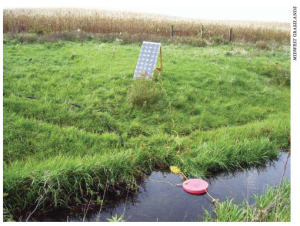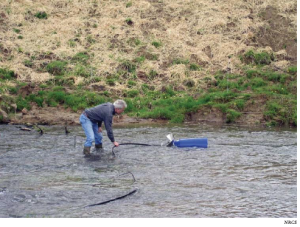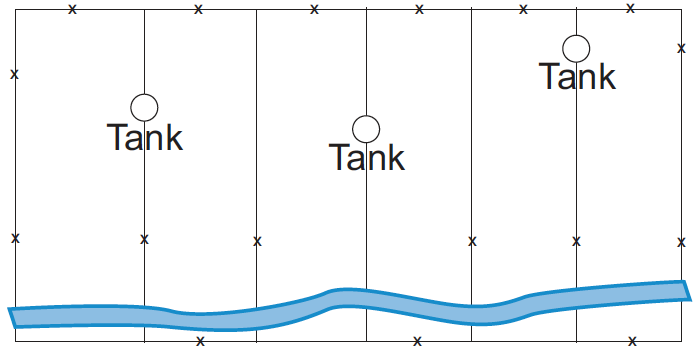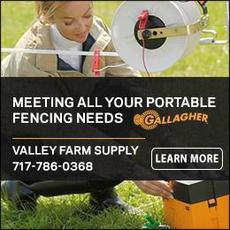In Part I of this series, we looked at a variety of ways to create paddocks so that we could water livestock from streams while at the same time managing them to improve stream corridors. But in some cases, using streams as a water source can lead to damage, or can prevent livestock from grazing paddocks well. A simple solution can be placing a water tank in the streamside paddock at some distance from the stream. This solution coincides with research showing that livestock will water from the tank more often than from the stream, especially if direct access to the stream is difficult. In addition, most livestock would prefer to drink from still water and prefer warmer water to the cold water from spring-fed streams.
Getting Water to the Tank
Livestock Operated Pumps
Livestock operated pumps are many times referred to as “pasture pumps” or “nose pumps.” These pumps are actuated by the livestock pushing thepump arm with their noses to pump the water from the source. The typical source is a pool of water in the stream. The inlet to the pump is suspended in the water to prevent it from sucking in mud. A one-way check valve is installed at the inlet so that the water in the pipeline feeding the pump does not have a way to return to the stream, thus keeping the pump primed.
These pumps work quite well, but keep the following in mind:
• They can handle approximately 30 cows per pump, so you may need more than one available to each paddock if your herd is larger than that.
• They are portable. It is a good idea to leave the inlets in place and move the pump to other established inlets to save time in setting them up.
• You must prime the pump initially for the livestock.
• Small animals, such as calves or sheep, will not be able to operate the pump. In cow/calf operations, a small pan is sometimes installed under the pump to catch overflow for the calves.
• The pump is limited to a distance of 150 feet from the water source. It will lift water about 26 feet, but only if placed close to the source of water. It is more difficult to operate as it has to lift water higher.
• It requires no electricity to operate.
(Here’s an additional On Pasture article on nose pumps.)
Sling Pumps
Sling pumps float in a stream and the movement of the current on the blades causes the blades to spin. Th e pump picks up water from the stream and moves it through internal tubes to the pump outlet through a hose to a watering facility. Th ese pumps come in various sizes. Th e smallest one can pump 550 to 830 gallons per day depending upon the velocity of the stream.
Keep the following items in mind if considering this pump:
• The pump takes a fair-sized stream to operate in. If the pump touches the side or bottom of the channel it will quit pumping. The smallest pump on the market takes a stream that is at least one foot deep with adequate velocity.
• The pump must be anchored well to keep it in place.
• These pumps are subject to curious passers-by if located on a stream used for fishing or canoeing.
• They can be easily disrupted and damaged by high water flows.
• The water tank that it pumps to must have an overfl ow so excess water can be removed from the area to prevent formation of mudholes. There is no way to put a system on the pump to stop flows when the tank is full.
Solar Pumps

One type of solar pumping system. This one pumps whenever the sun shines on the solar panel. It is set up in a paddock adjacent to the one with the livestock to avoid livestock damage to the solar panel. It pumps to a tank in the paddock with the livestock.
Solar pumps come in a variety of confi gurations. One common type is directly connected to a solar panel. It operates all the time when the sun is shining. Another type is actually a battery operated pump connected so that the solar panels charge the batteries. Th is type can be easily regulated to turn on and off as water use dictates.
Important considerations for solar pumps include:
• They may be expensive, although the cost varies considerably depending on the basic design.
• They require a three day water supply in reserve unless battery powered.
• They can draw water from open water sources or wells.
• They can be used to power a pressurized system to push water for long distances.
Engine Powered Pumps
Engine powered pumps are capable of pumping large volumes of water for long distances and more than 100 feet of elevation. The cost is generally reasonable.
Important considerations for engine powered pumps include:
• You must protect them from flood waters.
• The machine pumps water until it is shut down or it runs out of fuel. Some operators know about how long they want the pump to run and put a small amount of gasoline in the tank and let it pump until it runs out of fuel. Some overflow of the tank may occur and should be directed away from the tank.
In all cases with watering systems that pump from flowing streams, it is important to flood-proof the installation as much as possible. Many of the options described above will suffer serious damage during floods. All systems require some maintenance. They cannot be put into place and expected to operate without any attention.
The positive aspect of these systems is that they will provide water in locations where electricity is not available or where water cannot be pumped or hauled. In this respect, they are well worth considering.
Livestock Watering System Layout
The placement of tanks is restricted, to a large degree, by the kind of pump chosen and the source of water. Pumps can draw water for only relatively short distances, but some can push the water for very long distances.Below is an example of water tank placement in paddocks.
When considering tank placement, major drawbacks to having livestock travel long distances to water, even in travel lanes, is that they tend to deposit a significant amount of their manure in the lane that leads to and from the watering facility, and that they tend to lounge in the area of the watering facility. These issues defeat two major advantages of managed rotational grazing systems: keeping the livestock on the desired paddock so that they consume forages, and spreading the fertility (in the form of feces and urine) through the entire pasture rather than at lounging areas and watering points.







